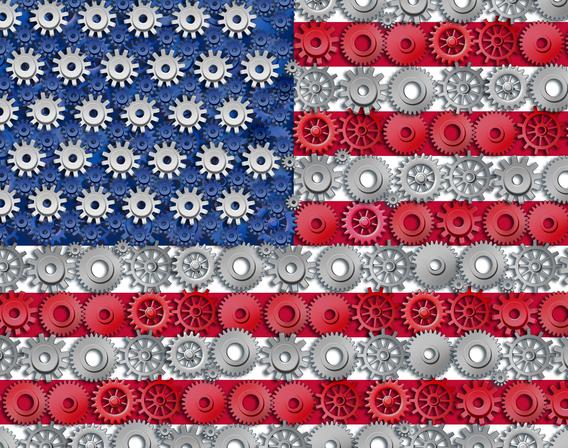On Manufacturing and Innovation
Manufacturing was once widely recognized as the outstanding strength of America and the basis of its prosperity, but manufacturing also has a more recent history of being almost a pariah. This newer view equated computer chips with potato chips, asserted that manufacturing is better left to others, and suggested that the nation is actually fortunate to be losing manufacturing and aiming to replace it with design, research, and services.
With the 2012 elections over, discussion about manufacturing subsided and changed course, but did not go away. Today the doubts of the American people about the loss of manufacturing are being addressed in a different way. Since Americans can’t be persuaded that manufacturing doesn’t matter, they hear instead: “don’t worry, manufacturing is coming back.” Now we have a stream of news articles and studies, all announcing, on the flimsiest evidence, that manufacturing is returning to America. But this is closer to fiction than it is to fact.
Innovation, in contrast with manufacturing, seems immune to ups and downs. Day in and day out, innovation is everybody’s favorite. We hear over and over that America must innovate to survive, America must innovate to compete in the global economy, and that Americans can do it because Americans are inherently innovative.
This discussion of innovation has things fundamentally backwards. It does not make sense to talk about innovation as if innovation was an end in itself. We could innovate until the cows come home and if we can’t translate that innovation into something substantial that adds to the economic output of the United States, it does little for America. If our strategy is to generate new ideas that other countries acquire, either as the foundation of a new industry or to gain an advantage in an old one, we will have the expense and glory of being innovators, and they will have the resulting industries and the economic benefits.
But in this era of globalization, and of worldwide profit seeking, our global corporations are strongly motivated to move their manufacturing abroad, not only in response to the availability of cheap labor, but also in areas of high technology where cheap labor is not the attraction but foreign subsidies are. And manufacturing innovation goes abroad with manufacturing.
Innovation in manufacturing matters; innovation in manufacturing is what turns ideas into things that change the world. It took the steam engine 150 years of steady improvement to evolve from being something that barely worked into a machine powerful enough to create the industrial revolution. Sixty years of continuing transistor miniaturization has produced a cellphone you can carry in your shirt pocket with computing power that once required several large rooms to hold. And this cheap computing power is transforming the world.
In a less spectacular way the manufacturing of steel, of paper, or glass, or automobile tires, follow the same path. There are ideas, and then innovation in the manufacturing process steadily improves on them. Much of the progress, and the competition, in manufacturing, is based on incremental innovations whose cumulative effect is enormous. But manufacturing’s steady improvement also means that once you are out of an industry it’s hard to get back in. Your workers’ skills are out of date; the underlying networks of suppliers have gone out of business.
This picture of innovation — tied to manufacturing and incremental in nature — is very different from the popular picture of a few dedicated young programmers putting together a startup that sweeps the world. But it is this popular and easy and attractive picture of innovation that dominates many discussions about how to increase innovation in America.
Why can’t we just stick to this attractive startup picture? Do we really need the hard work of manufacturing and manufacturing innovation in America? We know we do need manufactured goods, they are a part of daily life, but isn’t there some other way to get the manufactured goods we need?
Here are the three ways we can get them: (1) produce them in America (2) trade something else we produce for them, or (3) buy them with dollars that don’t get spent on American goods, but simply remain in foreign hands as future claims on our economy. Today the third option is increasingly what we do.
The Chinese government, alone, now has more than two trillion dollars generated by these trade deficits, and this amount grows daily. This is an enormous resource, available whenever needed, to buy promising, or even full-grown, technology and companies. And who believes that in today’s world a buyer with two trillion to spend cannot wield major economic and even political power?
Despite this, many still proclaim that free trade benefits everyone and point as proof to lower prices for the imported Asian products. But lower prices are not low if you lose your job to get them, and the mutual gains predicted by free trade theory do not in fact materialize in a world where the well thought-out subsidies and controls of foreign governments create persistent trade deficits for our country.
We are allowing much of manufacturing, the great innovation engine that turns ideas into reality, to vanish quietly from our shores. Our global corporations may be benefitting from this; most Americans are not.
It is time for the steady wasting away of manufacturing, and the consequences of that wasting away, to become a matter for national debate, and to remain a matter for national debate, until the problem is resolved. Action is needed, and strong actions should be considered with a full understanding of the enormous importance of what is really happening.
About the author:
Ralph Gomory –
Research Prof. NYU, Pres. Emeritus, Alfred P Sloan Foundation, Former IBM SVP Science-Tech




Leave a Reply
Want to join the discussion?Feel free to contribute!